Fishing For Trout: Full Article
I’m a fishing guide, and I put this article together because most articles online are crap, provide misinformation and bad advice, or they are just missing a lot of good information. I have stood beside and taught thousands of people how to catch trout properly
This is what you need to know, and all the information comes from experienced trout guides with over 37 years of expereince.
This is the most comprehensive guide on trout fishing you will find anywhere and the information comes from experienced guides. I’m going to share my knowledge from 22 years of guiding for trout and will explain the most effective fishing tactics for trout, the best baits, and lures, as well as trout feeding behaviors.
Be sure to read through to get some of my best methods and tips for fishing them throughout all four seasons.
Trout fishing changes throughout the season because the trout’s feeding habits change based on water temps, oxygen, cover, food, and spawning. I and other guides know this and adapt and change with the trout so we keep catching fish. You must change bait and tactics if you want to keep catching trout too.
I will also reveal the 6 key things guides know and do that allow them to catch ten times more trout than regular anglers.
About Trout Fishing
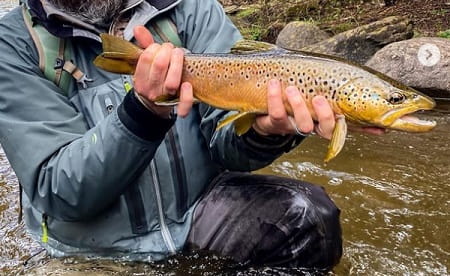
Fishing trout can be done anywhere that trout tend to live which includes lakes, ponds, reservoirs, streams, and rivers, and I will discuss them all.
I use different methods based on the type of water fishing. There are plenty of options for baits, lures, and flies that I have found effective for trout.
Common Trout Species
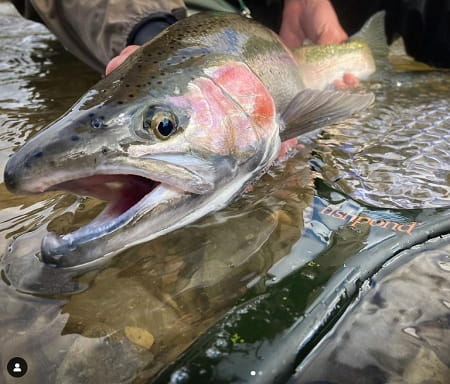
There are many common trout species around the world, some are native trout which means they have always been there while other trout species are called non-native trout which means they were introduced in the area to create a new trout fishery.
Rainbow Trout: The world record is 21.77 kg (48 lbs. 0 oz.)
Rainbow Trout are native to North America with a wide range throughout the USA and Canada. They average 1 to 3 pounds in small creeks and rivers, but in some water bodies they can grow much bigger, and 10-pound rainbows are possible.
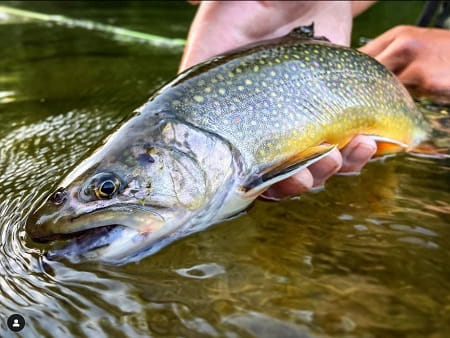
Brook Trout: The world record is 6.57 kg (14 lbs. 8 oz.)
A native trout to upper North America, the brook trout averages 8 to 12 inches on most rivers, but in some parts of Canada, the average can be 2 to 5 pounds with some over 10 pounds.
Check out my methods and baits for Brook Trout Fishing.
Brown Trout: The world record is 19.08 kg (42 lbs. 1 oz)
A native trout in Europe and introduced to many areas of North America. Brown trout is my favorite trout species because it averages 2 to 4 pounds on many rivers and because it’s more challenging than other easier-to-catch species like rainbows and brookies.
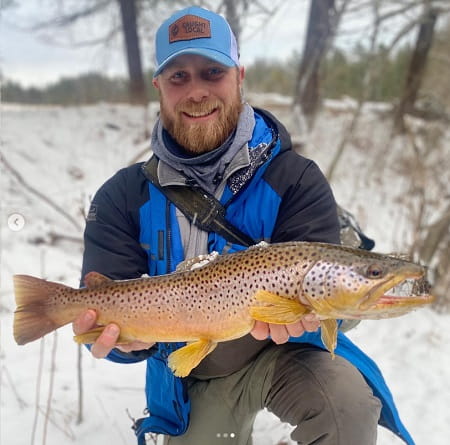
Also, known as browns, they are weary, yet aggressive on many types of baits, and around the great lakes region, some are a migratory strain with average sizes between 3 and 8 pounds with many over 10 pounds caught out of many rivers.
Learn more about these in my article Great Lakes Migratory Browns: A Complete Guide.
Cutthroat Trout: The world record is 18.59 kg (41 lbs. 0 oz.)
Native to the Western USA and pacific ocean streams, the Cutthroat trout in some larger water bodies averages 12-20 inches in length and grows to an average of 2-5 pounds.
Bull trout: The world record is 14.51 kg (32 lbs. 0 oz.)
Bull trout are not like other species of trout. Adults are very aggressive and feed primarily baitfish, and have a small range in northwestern North America, primarily in the rocky mountains area.
They are part of the Char family.
Lake trout: The world record is 32.65 kg (72 lbs. 0 oz.)
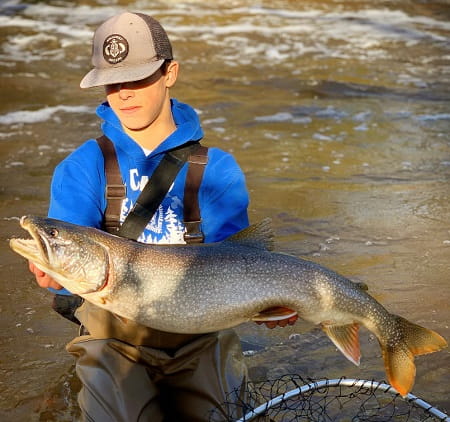
Unlike most other trout species, as their name implies, the lake trout is primarily a lake-dwelling trout and one of the largest trout in the world.
On rare occasions especially during the fall spawn they might be caught in the lower sections of rivers as seen in the image from our photographer Matthew.
But this is an exception and they generally do not inhabit rivers, at least not for long.
Steelhead Trout – The all-tackle world record steelhead is 36 pounds.
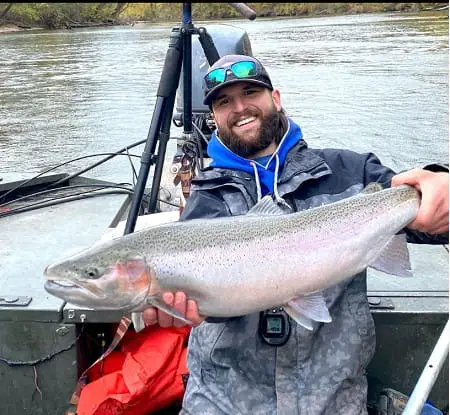
Some call them just steelhead, others call them steelhead trout, either way, the steelhead trout is a migratory rainbow trout native to the western USA and Canada on the pacific ocean.
Steelhead were also introduced in the 1900’s to the great lakes where it now thrives.
An average-sized great lakes steelhead on most rivers is 3 to 6 pounds, and an average-size steelhead on most west coast rivers is 5 to 8 pounds.
For more on this awesome species see my article Steelhead Fishing: A Complete Guide
How To Fish For Trout
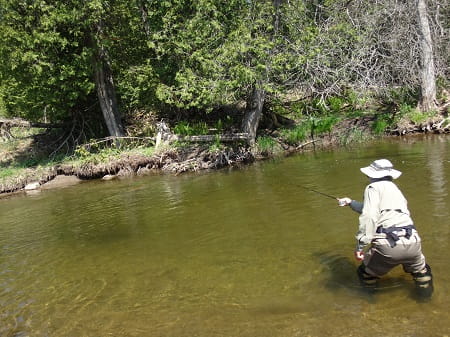
I use many methods to catch trout , so whether you fish still water or you fish trout streams. Common trout fishing methods include the use of a spinning reel with a bait fished under a float, or by casting lures.
I will cover all the methods below in much more detail and let you know which ones are the most effective and why.
Where To Fish Trout, And When To Fish Trout
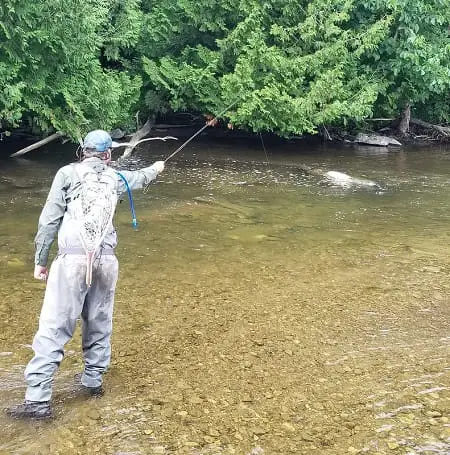
If you want to catch fish you first need to know where to go, and when are the best times to fish.
Often, most anglers will fish for trout in the spring and early summer but fishing for trout can be good all year round. There are pros and cons to fishing at different times of the year and I’ll discuss each season below.
Where to fish trout will depend on where you live. Often you can find information on your local “Department Of Fishing” website, or drop into your local fishing store and ask them where to go for trout.
Often you will have options to fish still waters, small creeks, and large cold rivers.
Trout require cold water, clean water, well-oxygenated water, and food. In some cases, trout will also seek out structure but that is not a mandatory requirement. Find these areas and you will find trout.
Finding Trout In Lakes, Ponds, And Reservoirs
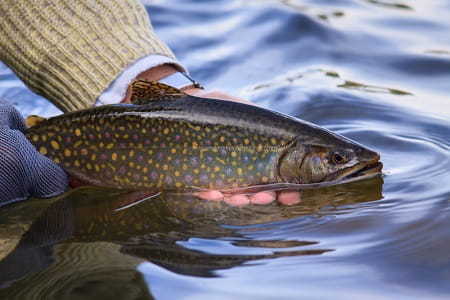
Still waters like lakes , reservoirs, and ponds can have trout in them and often the trout will be found where the water temperatures are suitable for the trout’s survival as well as where the food is.
Trout will often be found near the surface in the spring and deeper in the lake during the rest of the year. They will also feed near river mouths in the spring and fall.
If available, structures like rocks, shoals, and sunken trees will attract fish in lakes. They will either use the structure to hide near or feed near.
Trout in lakes will also feed on emerging and floating insects so you may find trout near gravel areas where these insects reside. They will also feed on baitfish. Check out my articles:
- Trout Fishing Reservoirs: Guide Tip And Tactics
- Trout Fishing In Ponds: A Complete Guide
- Trout Fishing In Lakes: A How To Guide
Finding Trout In Rivers And Streams
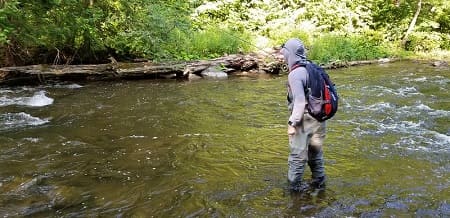
When I’m fishing trout rivers, I look for undercut banks, places with optimal food sources, feeding lanes, current seams, the mouth of tributary streams, and structures like logs, and rocks.
During the summer, pocket water and shallow rapids can be very good spots because they are well oxygenated.
Deep holes are often a magnet for big trout especially in low clear water, or in the winter when the trout are cold or resting. During high sun, the trout will often seek out structure and depth.
Regardless, if a river angler wants to hook more trout, they should fish moving water and avoid still water. This is because the trout prefer moving water since it is well-oxygenated and the moving water brings them food.
I tell my clients that a river is like a giant conveyor belt of food and trout do not need to move far in a river once they have found a spot that is safe, cold, and has plenty of food
Fishing For Stocked Trout
Local fisheries will add hatchery trout to many ponds, some lakes, and some rivers to improve fishing. This is known as stocking fish and it’s mostly done in late winter and early spring.
Often, these hatchery fish are easy-to-catch fish if you know where they are and the methods for fishing for stocked trout. Stocked trout are a favorite for many anglers and kids.
Often, the most stocked trout will be rainbow trout, with some browns, because they both can survive well in a pond or a stream, and occasionally brookies will be stocked in some cold rivers.
If you check your local fisheries website, you may be able to find the areas they stock and the times that they stock. Often, two or three days after they put the fish in will be the best time to fish them.
Depending on the area, most of these hatchery trout will be 6 to 12 inches long and some will survive many years and can get big.
Often, stocked waters will have extended fishing rules, harvest limits, and year-round fishing so check your local fishing regulations.
Fishing For Wild Trout
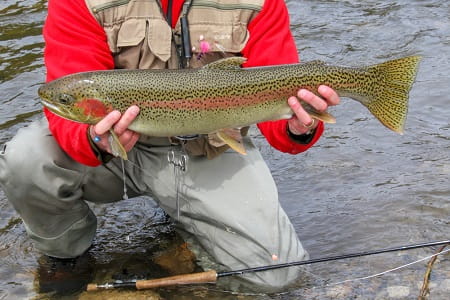
Wild trout are often found in cold creeks and rivers where naturally reproducing trout populations thrive.
Rainbow trout and browns are the most sought-after wild trout in North America.
Often, wild trout fisheries will have open and closed seasons so check the fishing regulations for your area before you head to your local streams.
Spring Trout Fishing
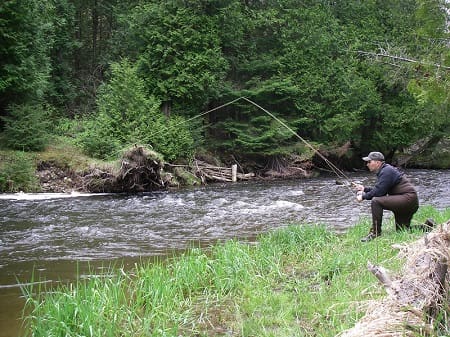
Many anglers regard springtime as the best time to fish for trout and for good reason.
Many trout are hungry after the long cold winter and with ideal water temperatures, the trout are actively feeding and are easier to hook.
Stocked trout ponds and streams will have ideal water temps in the spring and trout will be on the hunt for food.
Rainbow trout will spawn in the spring so they might be more spread out than other trout and that can make them harder to catch at times. I discuss this more and discuss the best fishing methods, best times, and best baits and lures for Spring Trout Fishing on another page.
Early Season Trout Tactics
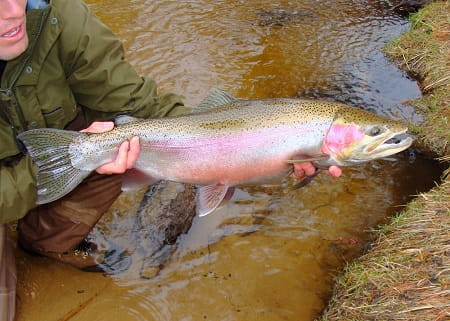
One issue anglers have in the spring is high water and dirtier water streams due to rains and snow melt.
If you encounter these conditions slow your presentation down and fish with a bigger bait or lure in a bright color like chartreuse.
In early spring it can still get cold at night and that can mean water temps will drop fast overnight which can cause the trout to be lethargic and inactive early in the morning. If this is the case, fish in the late morning and afternoon for the best success.
Also, if the water is cold, slow your presentation down as much as possible.
Summer Trout Fishing
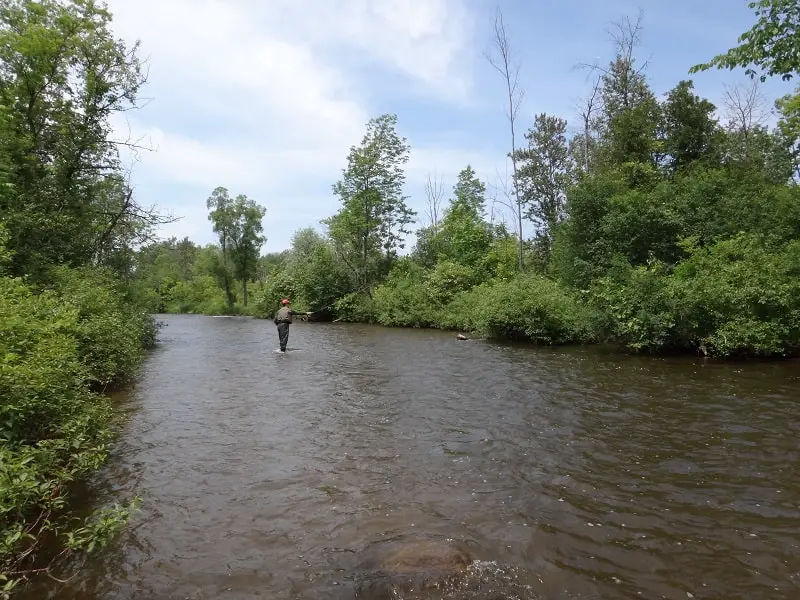
Cool streams, cold creeks, and tailwater rivers are often the best places to target trout when the weather is hot.
Some streams will warm up too much during the day and therefore the best fishing will be overnight and the first few hours after dawn when the water is coolest.
This is also when the insects will be most active which also activates the trout. Often, trout will seek out faster more oxygenated water on colder creeks.
In some cases on warmer rivers, the trout will seek out and hold near or below cold water upwellings, and incoming springs, or they will concentrate below cold-water tributaries.
It’s best to follow my tactics and tips for Trout Fishing In Hot Weather.
Summer Tactics
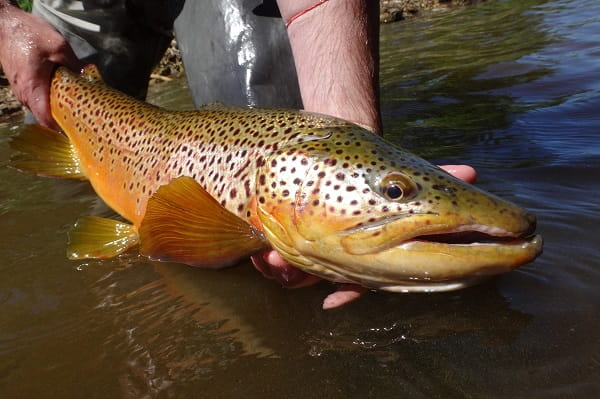
Summer is also a time for low clear water so an angler may need to switch to a smaller bait and they should be very stealthy when approaching fish and when wading.
Food sources are plentiful in the summer with good and consistent insect hatches as well as big insects like grasshoppers, crickets, and large stoneflies which can all be very effective.
Trout will also be feeding on baitfish like sculpins and minnows. Mouse lures and a mouse fly can also be good, especially at dusk and dawn. Fishing for trout at night can also be good but ensure you know my tactics and safety tips for trout fishing at night in the dark.
Your local pond will likely be too warm on the surface so you will need to let your baits and lures sink deeper.
For more on catching trout in the summer check out these articles.
- Summer Trout Fishing Tactics For Rivers
- Late Summer Trout Fishing Tactics
- Best Time To Fish For Trout In Summer: 4 Best Times
Fall Trout Fishing
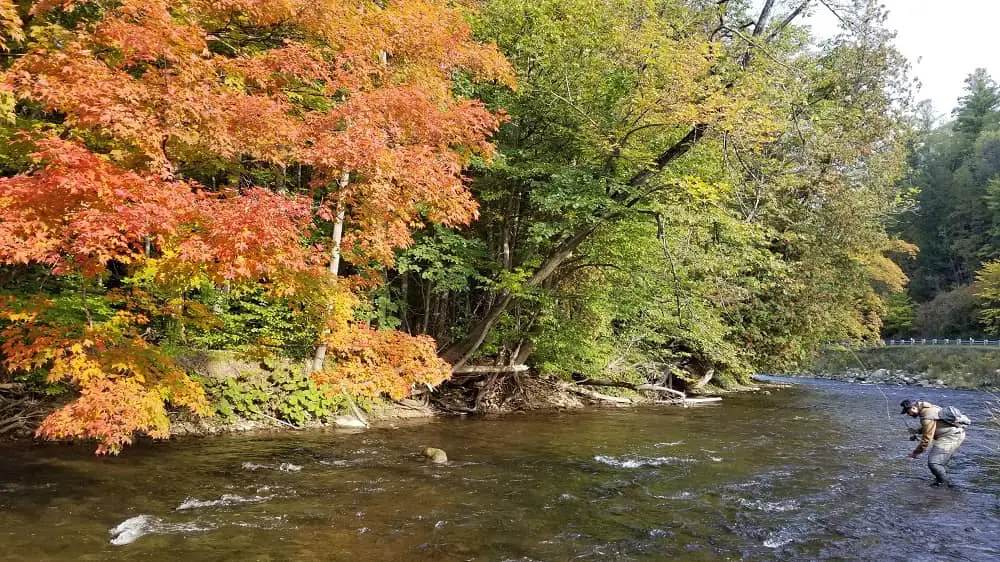
Fall is one of my favorite times for to target trout.
The trout are often feeding heavier in the fall to prepare and fatten up for winter and they are willing to grab a bait or lure.
If there are salmon, steelhead, or browns in your local river, a bait like rainbow eggs or salmon eggs can be a very good choice.
Winter Trout Fishing
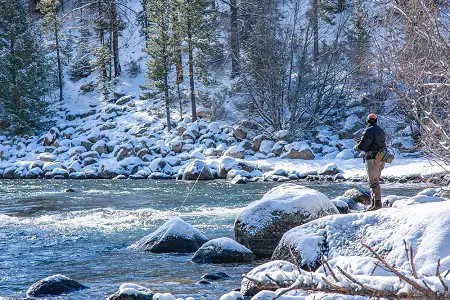
Winter is when the anglers disappear, but, the trout are still there and for guides like me and anglers that know how to fish trout in the winter, lots of trout can be caught.
When winter river fishing for trout, the key to catching them is to slow your presentation down, use smaller lures and a smaller bait, and fish deep holes where the trout concentrate in the winter.
All methods, including fly fishing, are effective in the winter. A small fly like a midge or a small black stonefly is often the best choice.
If an angler is dressed properly and understands how water temps affect trout holding spots and feeding patterns, winter trout fishing can be great.
The Best Trout Fishing Tackle and Gear
I have a huge list of essential and non-essential gear that my guides and I recommend to my clients. You can see that list and why I recommend it on my page River Fishing Gear That Guides Use and Recommend. If you are a fly angler also check out the page Best Gear For Fly Fishing.
Trout Rod and Reels
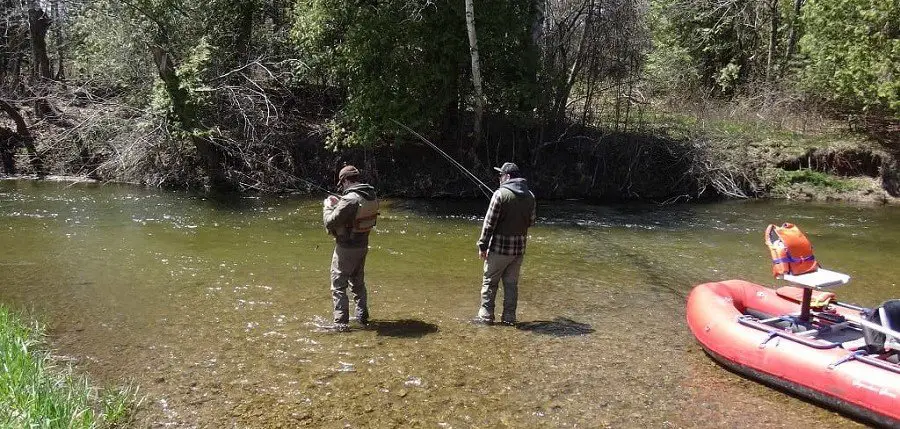
Most trout fishing is either done with a spinning reel and rod, or a fly fishing rod and reel. Some anglers will also use baitcasting reels. Spinning reels are the most popular and are easy to cast whether you’re fishing with bait or if you are casting lures.
A light to a medium-light 7-foot rod is a normal rod size for general trout fishing. However, there are some methods and situations along the river that might require a shorter or longer rod. I discuss this on my page Best Rods For Trout.
For a trout spinning reel, I use a size 15 to 20 (1500 to 2000).
I discuss the best spinning reel for trout on my page Best Gear For Trout Fishing.
Trout Fishing Line And Leader
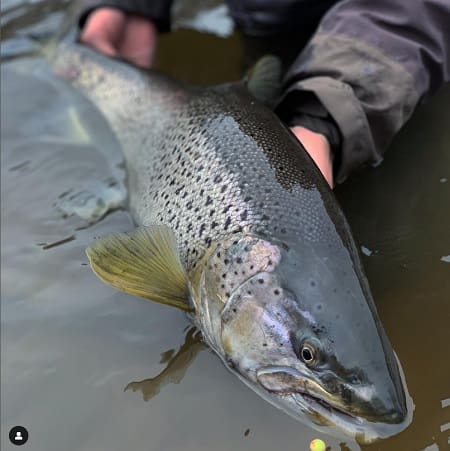
The line and leader are very important and they will change or should change depending on the fishing technique you are using.
If I was only allowed to use one line for all techniques it would be a good quality 8-pound monofilament line. However, I have different reels and rods for different methods because an 8-pound line is too heavy for some trout.
These are my line recommendations:
For float fishing and drift fishing small streams, – a 6-pound monoline line is good.
For fishing with lures, a 15 to 20-pound braided line is best. A braided line will help you hook and land more fish due to low stretch and better hook sets.
Check out: The Best Fishing Line For Trout: What The Guides Use
I generally use a fluorocarbon leader and I change sizes based on many factors such as the size of the fish, the speed of the river, the water clarity, etc.
I discuss the best leader line, brands, types, and leaders for different situations on my page What Pound Test Leader For Trout.
Nets
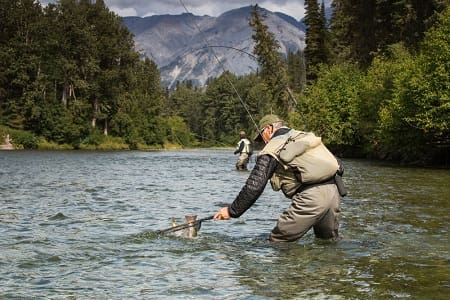
I’ve heard way too many stories of guys losing huge trout simply because they didn’t have a net. And, I have seen it happen a few times.
Also, If you plan to release some trout, keeping them submerged in the net while you get the hook out and get your camera ready will greatly improve the survival of the trout.
Check out my favorite lake nets and wading nets for river fishing.
Trout Bait Hooks
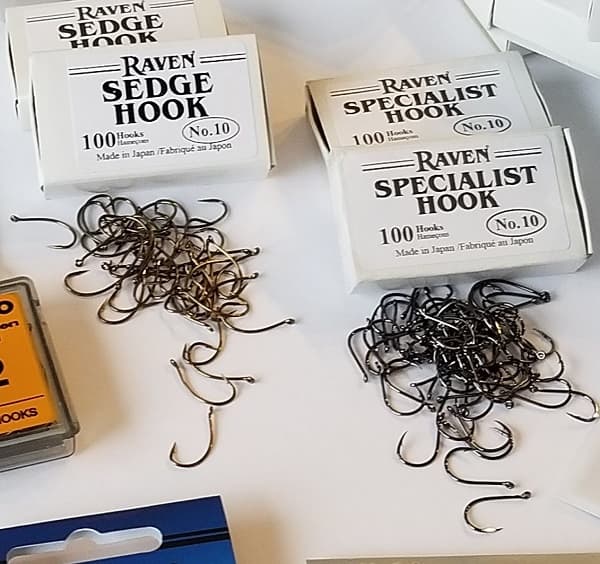
This is a big mistake many anglers make, they just use a bad hook.
Guides use specific hooks that are short shank, wide gap, and have razor sharp points. They use these because they are proven to hook well and they hold the fish well.
A treble hook is for lures, not for bait, so don’t use them for bait fishing.
Generally, a size 8 or 10 Raven Specimen or Gamaktsu Octopus hook will work for almost all trout fishing situations. But if you want to dial it in and you want to hook and land more trout like us guides do, you must use the right size hook for your bait, and for the size of the trout in the areas you fish.
I discuss the best types of trout hooks, the right sizes for the bait, and how to properly rig your bait on the hook all on my page Best Hooks For Trout.
Trout Fishing Weights
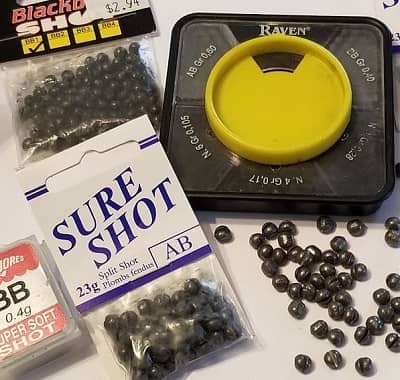
When I’m fishing trout I use split shots that are dark grey or almost black and I use the ones without the little wings that are meant to help you take them off. DO NOT use shiny silver weights.
Only use bell sinkers and pencil lead for plunking and drift fishing methods which I will discuss below.
The split shot will aid you in casting and will help sink your bait faster.
Best Knots For Trout Fishing
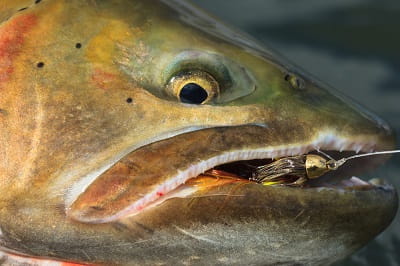
When you finally get that big fish on, you do not want to worry about your knot. Confidence in your knot will allow you to fight the fish better.
There are only 2 or 3 knots that you need to know for trout fishing.
I use the improved clinch knot or the double Davy knot for most of the trout fishing I do.
If you use a braided line consider the Palomar knot and the uni knot.
I discuss my favorites on my page Trout Knots Every Angler Should Use and Fly Fishing Knots For Beginners: Top 4 That Fly Guides Use.
Fishing Techniques For Lakes and Ponds
If you are planning on fishing trout in a lake there are different techniques you should use.
- Lure Fishing – Casting a lure from shore, or from piers or docks.
- Bait Fishing – Casting a bait from shore, or from piers or docks is a common method.
- Boat Fishing – Casting a lure or trolling from a boat are also good methods.
Focus your fishing around structure, fish the depths where the trouts prefered water temps are, and use a fish finder/sonar unit to help you locate baitfish, structure, and the trout.
Bait Fishing For Trout In Lakes and Ponds
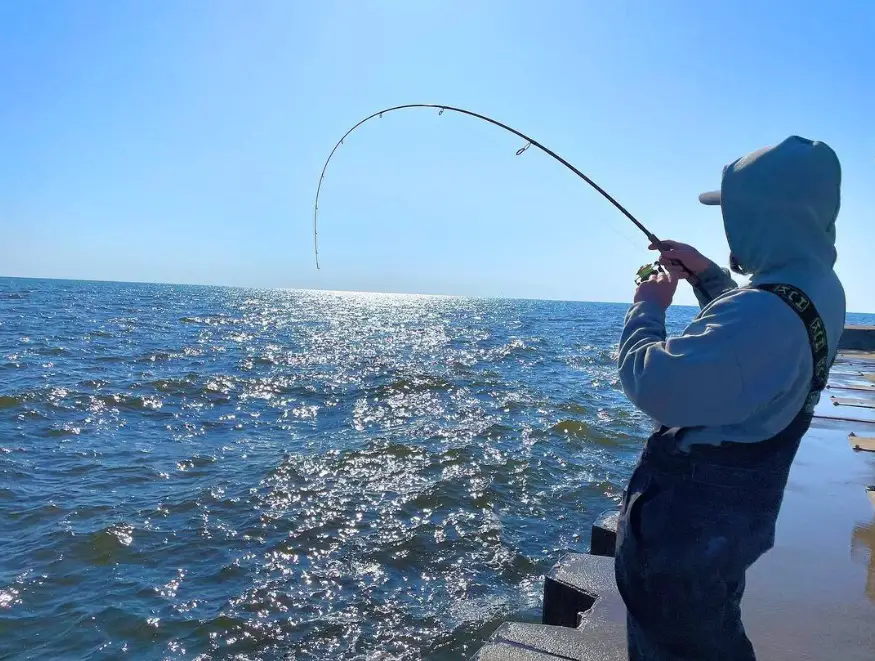
I do not recommend artificial baits for still fishing on a lake unless the trout a stocked.
Stocked trout are dumber than dumb but wild trout in a lake are looking for natural and live baits like minnows, leeches, or maybe salmon eggs.
Use methods like float fishing with slip floats or a method called plunking which I discuss below.
Fishing Line and Leaders For Bait Fishing Lakes and Ponds
Because you are fishing in still water, the trout have plenty of time to check out your bait and for this reason, you need to use a thin fishing line and/or a fluorocarbon leader.
If I do still-fishing in lakes my mainline is 4-pound fluorocarbon unless the trout are over 7 pounds, then I might upsize it to 6 pounds or 8 pounds.
Plunking For Trout
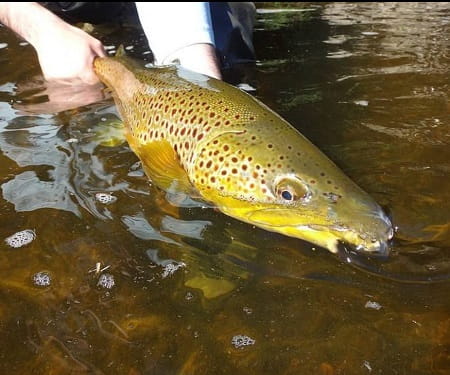
Plunking is a method of still fishing used in still water, lakes, or moving water with slower currents.
The idea is the bait rig is cast out and allowed to sink and held on the bottom with a large weight. You put light tension on the line and then sit and wait. You watch your rod tip and if it starts twitching or bouncing you set the hook.
Since you are fishing in still water I do not recommend artificial baits and instead always go with organics baits or live baits like minnows, worms, or leeches, and make sure they are on the proper hook.
Using the right hook will help you hook and land more trout. I discuss this method in more detail and show you the proper Plunking Rig For Trout and steelhead at this link.
Bobber And Float Fishing Ponds And Lakes
Another great way to catch trout in a lake is to use a float or bobber.
With bobber fishing use a thin upright bobber like the Raven SM float for water under 10 feet deep or when setting your depth less than the length of your rod.
When fishing any water deeper than your rod’s length, use a slip float and bobber stop. I prefer the size 1 or 2 Drennan Crystal Piker Float.
Lure Fishing For Trout In Lakes and Ponds
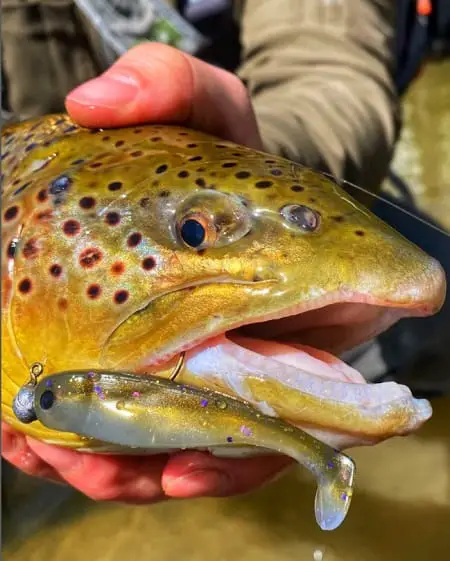
Artificial lures are the most common way to fish a lake and are often the best way to catch trout.
Casting artificial lures such as crankbaits, spoons, spinners, and jigs using spinning reels can be good when fishing from shore or from a boat.
Check out Lure Fishing For Trout and The 31 Best Lures For Trout which is where I tell you the best lures for all situations, the best sizes, and the best colors, based on my 36 years of experience catching trout on lures.
4 Best Lures For Trout Lakes and Ponds
- Crankbaits – Use 3 to 5-inch shallow swimming Rapalas when the trout are high in the water column. Use deep diving crankbaits when you need to get your lure to deeper fish.
- Spoons – Spoons like Little Cleos, Mepps Syclops Spoon, and Luhr Jensen Krocodile Spoons are great for trout and you can fish them shallow or deep depending on how long you let the spoon sink before you retrieve it. Silver flashy spoons, bright colors, are often the best colors and my preferred sizes are 2 to 4 inches.
- Spinners – Blue Fox Vibrax and Mepps spinners are proven to work well for trout in any type of water. Use sizes 2 to 4 and try silver, bronze gold, and bright colors.
- Jigs – You may not think of jigs for trout but jigs are very good at fishing for very deep trout held near the bottom. 2 to 4-inch jigs with a 3/4 to 1/2 ounce jighead and then tipped with a twister tail, grub tail, or gulp minnow are great. Also, a jig head tipped with a live or salted minnow, or leech is also excellent.
Trolling For Trout
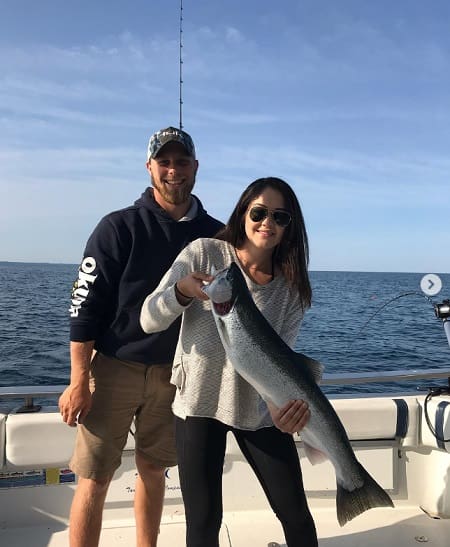
Trolling for trout is mostly done when fishing lakes or maybe on a large pond out of a small boat or canoe.
Anglers will troll with lures using a flat line method or with the aid of either dipsy divers or downriggers to get the desired depths.
Flat Line Trolling – Flat line trolling is simply letting the line straight out the back of the boat with no added device for getting the lures deeper.
If the trout are high in the water column you can use most lures like spoons, spinners, and shallow-running crankbaits.
If the trout are deeper use deeper diving crankbaits and run them as far back as you need to get the desired depth.
A misconception anglers have is that all lures need to be trolled far back from the boat, however, 30 to 50 feet is all that is needed when flat-lining shallow lures, and when running deep diving lures they will often run deeper the farther back you run them so I tend to use line counter reels when trolling so I can achieve the desired depth from my lures.
If the trout are very deep like in the summer, and lake trout go very deep, a device like a dipsy diver can get your lure down over 60 feet deep. you will need a line counter reel to help you gauge the depth.
If you need more precise depths, or you want to fish the shallow running lures like spoons very deep, I use downriggers.
Best Lures For Trolling For Trout
- Trolling spoons and Williams Wobblers or good options to catch trout – use silvers, golds, bronze, and brighter flashy colors in 3 to 4 inches.
- Spinners are good lures to troll – silvers, golds, and copper colors are good and brighter colors are also good. Best in sizes 3 to 5 are good options.
- Crankbaits are good for trolling – 3 to 5 inches is best.
Line And Leader For Lure Fishing Lakes And Ponds
If you will be trolling you should use a slightly heavier line. When flatlining I really like a 20 to 30-pound braided line because it has no stretch and provides a better hook set. I will often add a 16 to 36-inch 10 to 12-pound fluorocarbon leader attached to the braided mainline by a swivel.
But when I’m using dipsy divers, or down riggers I like to use a fluorocarbon line of 12 to 14-pound test. If I use a braided line or mono line I will also add a fluorocarbon leader.
Fishing Techniques For Rivers And Streams
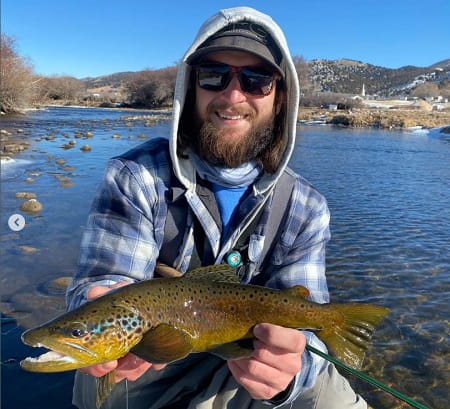
Fishing techniques for a trout stream will depend on many factors including what your favorite technique for catching trout is.
As an example, when I’m fishing slow-moving water it is best to use the float fishing method.
But when I am fishing in fast and deeper water I catch more fish when drift fishing. Different techniques should be applied based on the conditions.
For many spin fishing methods are top on the list and I discuss them on my page Spin Fishing For Trout.
Bait Fishing For Trout In Rivers and Streams
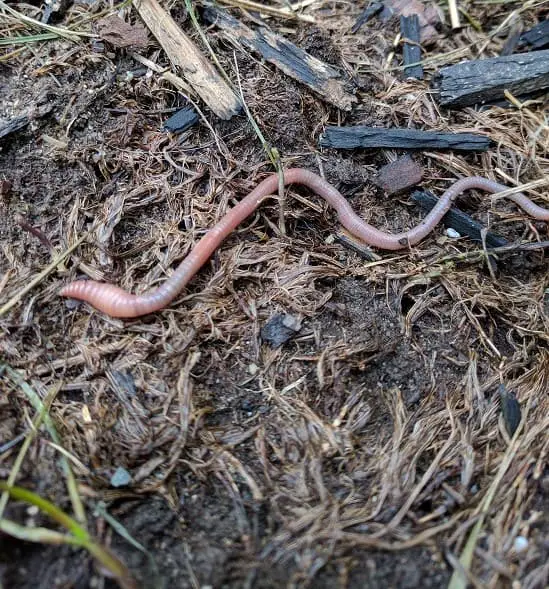
Bait fishing in rivers is a great way to catch trout, the bait can be fished under a bobber, or free-drifted.
Baits can also be flies, minnows, artificial baits, and even a jig suspended below a bobber.
I will discuss the best bait fishing methods below.
Bait Fishing Line and Leader For Fishing Rivers
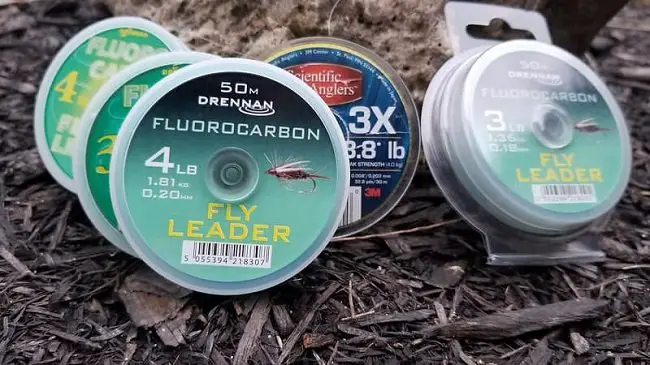
When I am bait fishing in rivers, creeks, and streams effectively, I know the line doesn’t need to be to heavy and that lighter line will ofter be much better for line hy trout.
The best line for bait fishing is a 6-pound mono or 10 to 20-pound braided line.
I also use a good fluorocarbon leader that is thick enough to not break the fish off but thin enough that the trout won’t see it in the clear water. For most trout fishing I and other guides will use a 3 or 4-pound fluorocarbon leader.
Lure Fishing For Trout In Rivers And Streams
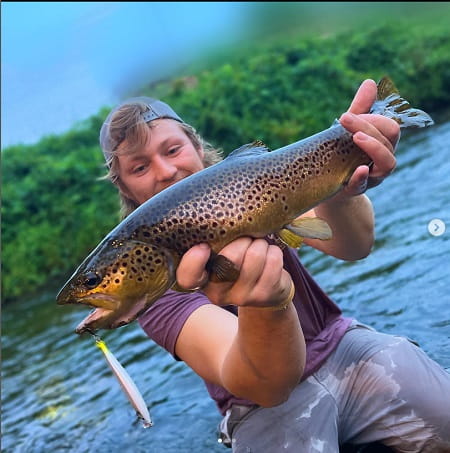
Lure fishing is another way that I have a lot of success catching all trout species in streams.
I have found spinners, spoons, and crankbaits are best, and I will adjust my retrieve to suit the activity level of the trout.
GUIDE TIP: I have found that a more erratic retrieve almost always gets more bites, so I will twitch and bounce all my lures, including lures meant to run straight like spinners and spoons.
For best results, I recommend casting at about a 45-degree angle across and downriver and then let your lures swing across the river and broadside to the trout. I do this with either a super slow retrieve or merely just take up the slack if needed as the lure swing across the river.
I also cover the water effectively by spreading out each cast and retrieve about 3 to 5 feet apart, working my way downstream.
Best Lures For Trout In Rivers
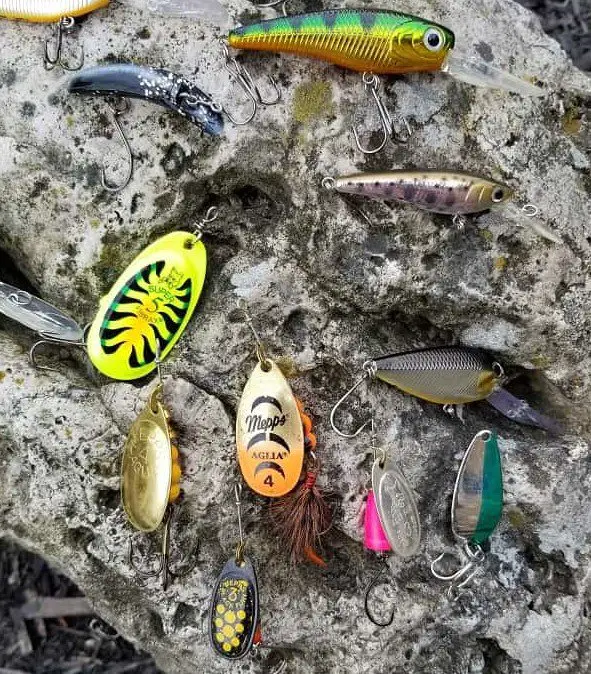
Even smaller fish will hit lures so I always have a variety of sizes from 1.5 inches to 4 inches long.
Species like bull trout mostly hit lures and they like big lures!
Browns and bows will also smash larger 4 to 6-inch lures like crankbaits.
My most effective lures for river fishing are spinners, spoons, crankbaits, plugs like Kwickfish and flatfish can also be excellent, and don’t forget jigs.
Line For Lure Fishing Rivers
I tend to upsize my fishing line compared to what I use for bait fishing and the reason is that the lure is big and is moving quicker so the trout tend to only focus on the lure and they are not as line shy.
I recommend a good 10 to 20-pound braid like Berkely Fireline. In very clear water I will often add a 16 to 30-inch fluorocarbon leader attached by a swivel especially when using braid or mono.
Another great line option is to use a good-quality fluorocarbon mainline.
FYI, there are some really crappy fluorocarbon lines that will twist and jump off your reel and cause all kinds of problems so make sure you use a good quality line like Seaguar InvizX Fluorocarbon Line.
Check out my recommended Fishing Line For Trout and the best brands, and sizes for different methods.
Float Fishing For Trout
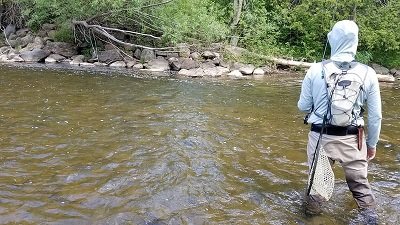
Float fishing is one of my most effective methods and because it is so effective and easy to do is used by many trout guides and by good anglers to catch trout.
With this method, I use a float which to some people is also known as a bobber, and I will suspend my bait below the float as it drifts down the stream, or as it sits in the pond waiting for a fish to crab it.
I have found that when float fishing I can effectively drift artificial flies, jigs, minnows, and crayfish, spawn, and if fishing in fast water sometimes I will even use artificial plastic baits.
Because float fishing is best done in sections of the stream that are 3 feet or deeper I save it for bigger and deeper sections of the river. I catch a lot of small and big trout when float fishing. To float fish effectively, I will add multiple split shot to the leader to get bait bait down.
I will use a spinning reel, a baitcasting reel, or based on my experience, the best reel is the Centerpin reel.
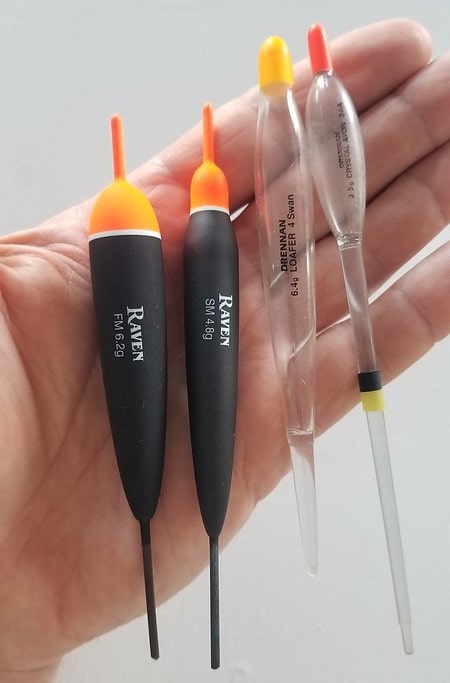
Just be sure that if you are going to be float fishing you use floats that are meant for river fishing.
After teaching and guiding thousands of anglers how to float fish I’m going to be honest and say that most guys are not very good at float fishing and that they catch far fewer fish than they should due to a few simple and easy to fix errors.
The reason is that most guys think all you need to do is cast the float out and let it drift down the river and then just wait for fish to bite.
This is so wrong!! And it’s even more wrong if you do this with the wrong type of float.
I have found that some floats are not very good for river fishing. A good river float does more than just detect a bite. A good river float will aid in finding the right depth as well as help control the speed of the bait, which are both critical to success.
Float fishing can be greatly improved if you implement the 4 fundamentals that I teach my clients and discuss on my float fishing pages. I will tell you the best floats, and the most effective leader setups, and baits, that I and other trout guides use on my page Float Fishing For Trout – An Expert Guides Best Tips.
Centerpin Fishing For Trout
Centerpin fishing is basically the same as float fishing except you are using a specialized reel called a Centerpin reel.
Centerpin fishing is primarily a method used by many guides and top anglers around the great lakes region and on the west coast, for trout, steelhead, and salmon.
With 30 years of experience in Centerpin fishing and with float fishing with spinning reels I can honestly say that Centerpin fishing is much more effective at catching fish than float fishing with other reels. It might even be the most effective method for catching trout.
See more at Centerpin Fishing For Beginners
Bottom Bouncing For Trout
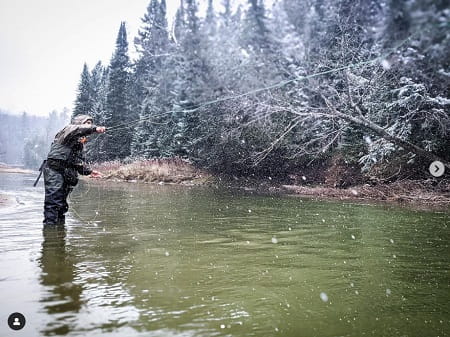
I love bottom bouncing for trout because it is the most effective way to fish bait for trout in shallower water under 3 feet deep, and when fishing in pocket water sections, or in faster sections. The only other method I have found to equal it’s effectiveness in this type of water is Euro Nymphing.
Even Centerpin and float fishing are not as effective in this type of shallow water and pocket water.
I use bottom bouncing for all species and with all baits.
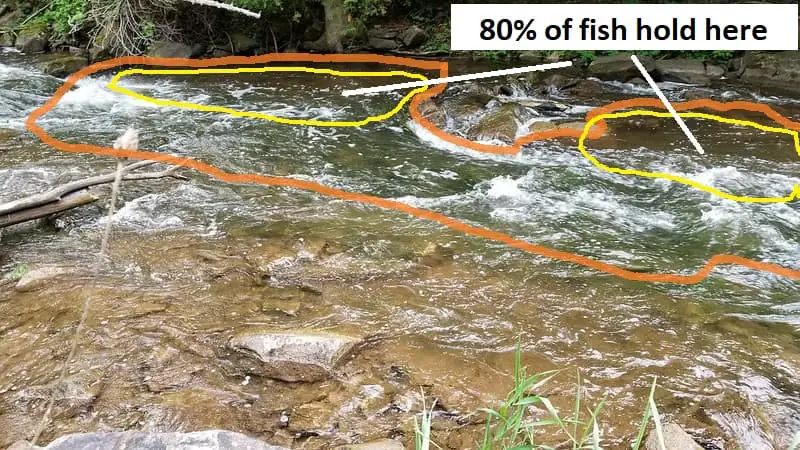
On tiny creeks, the brook trout and brown trout are often in 2 feet or less of ripple water and a bobber drifting overhead will spook.
With bottom bouncing I use a fluorocarbon leader with split shot or two, a hook, and bait, that it!
It’s much less intrusive, with only the little splash from the bait and split shot and you can easily fish this very shallow water especially if you cast upstream and stay behind the fish.
I show you how this method is done, how to set up your lines, what rod and gear is best, and even an advanced method that most anglers have never heard about on my page Bottom Bouncing – 5 Proven Guide Tips For More Fish. The advanced method is by far my most effective method for weary brown trout in streams.
Drift Fishing For Trout
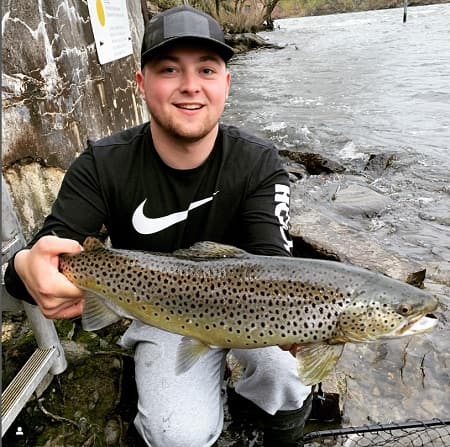
Drift fishing is very much like bottom bouncing just on a bigger scale and it’s much better for bigger sections of rivers, deeper water, and faster water.
Steelhead and salmon anglers use drift fishing on bigger rivers all the time with good success.
Since some trout rivers are also big and long casts to deeper water are required, Drift fishing is a good method.
The setup and method used for steelhead is the same for trout, and often the only thing that changes is that I will downsize the line and leader to be more suitable to the smaller trout.
I discuss drift fishing in more detail along with the best baits, hooks, rods and reels, and even show you my leader setup in my article Drift Fishing: Best Methods, Set-ups, And Best Baits.
Bobber Doggin For Trout
Bobber Doggin is a relatively new method of fishing with a bobber that is becoming more popular with the steelhead and salmon anglers of the west coast, and now some trout anglers are trying it in their streams.
I have used this method and know that it can work for all species of trout. Check this method out at Bobber Doggin: Trout, Steelhead, And Salmon Tactics
Baits For Trout
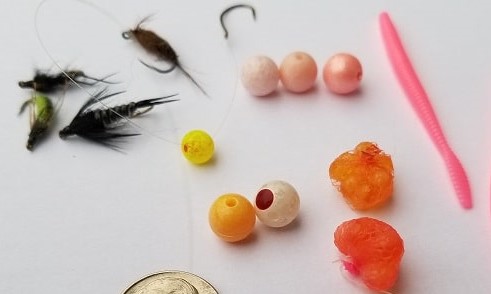
There are so many baits available for trout and if you study trout as I do, you know that trout are not very smart and they will often put just about anything into their mouths to sample or taste it. If it’s edible they will eat it, if not, they spit it out.
For this reason, in my opinion, and based on my experience of testing all the artificial crap baits that other websites tell you to use, they usually don’t work well and should be avoided an replaced with more effective baits. Replace them with baits that guides use, because those are the baits that are proven to work.
So what baits should you use?
Natural Trout Baits Are Best
Natural organic and live baits will almost always be the most effective baits, with some exceptions to this rule.
Try these very effective trout baits:
- Salmon eggs or trout eggs
- Worms
- Minnows
- Grubs
- Leeches
- Crayfish
Be sure to check out our page of the baits that our guides find to be the most effective. See, Best Trout Bait – The Only 5 Baits You Will Ever Need. Since I’ve updated that page many times there are actually about 15 baits that are effective. I discuss how and when to use them and some rigging tips too.
Artificial Trout Baits
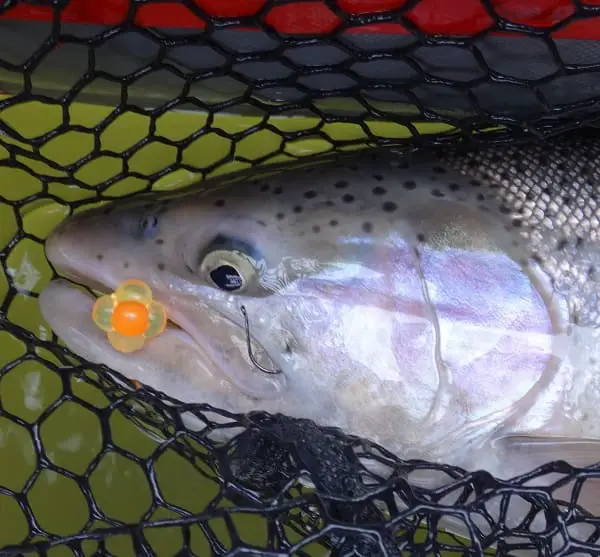
Plastic grubs or scented artificial baits like Berkley Maggots, Berkley grubs, and Berkely gulp leeches can all be good in faster-moving water where the trout need to grab these baits quickly, but in still waters, I would avoid these baits and use natural trout baits.
Plastic single eggs are also very effective, especially in faster water. Egg cluster baits can also be effective in faster, and off-colored water.
Dough baits should only be used for stocked trout, and even then, dough baits are not very good when compared to real worms, grubs, or fish eggs, or other live or organic baits.
GUIDE TIP: Don’t use dough bait in a jar. Dough bait is for amateur trout anglers that don’t know any better, and they rarely catch many trout. Also, don’t use corn for the same reasons. You rarely see trout guides using them, and for good reasons.
Soft Plastics For Trout: Bugs, Crickets, Tubes, Grubs
I do use soft plastics like Bugs, Crickets, Tubes, Grubs, twister tails, eggs, and more but only in faster water and only when more natural baits are not working. When still fishing, stick with live or organic baits.
Fly Fishing For Trout
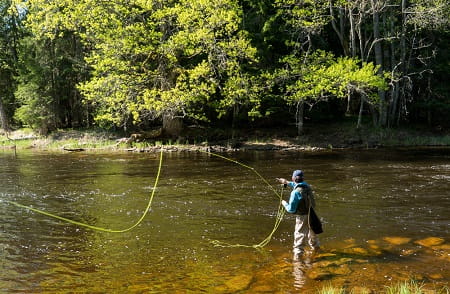
Fly fishing for trout is used by a lot of river guides and it is my preferred method for fishing for trout in rivers, especially in certain types of water.
Fly fishing simply works well for catching trout, and I can cover all levels of the water column with this method.
And since aquatic insects are a large portion of many trout’s diets, you can easily imitate these aquatic insects with fly fishing.
Fly fishing covers many food sources, from an insect floating on the surface to nymphs or sunken insects below the surface, to baitfish, leeches, crayfish, frogs, and even a mouse. I can imitate all of these things fairly effectively when fly fishing.
Be sure to check out my article Fly Fishing For Trout.
Flies For Trout Fishing: Not Just For Fly Fishing
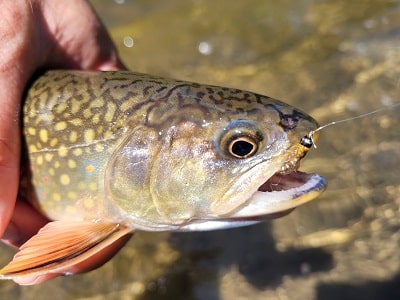
A fly is basically a type of artificial lure that is often made of feathers and furs that are wrapped around the hook in a specific way to imitate a type of food source.
Flies are a fantastic bait for trout because in a lot of rivers, aquatic insects are the primary food source for trout, and artificial flies imitate these very well.
For this reason, flies can be and should be used with all methods, not just when fly fishing. I use flies under a float with spinning reels or Centerpin reels, and when bottom bouncing and when drift fishing.
There are plenty of great flies for trout fishing and the flies that I use will depend on the method and the conditions. Click the link to see the best 29 trout flies.
As an example, if the trout are rising and eating bugs on the surface I will use dry flies. If the trout are feeding below the surface, I will either nymph fish for them or I will streamer fish for them.
Casting A Fly Rod
Casting a fly rod is probably the toughest part of fly fishing but after teaching hundreds of anglers how to fly fish I can assure you it’s still fun, and with some practice, it really is not that hard.
Dry Fly Fishing For Trout
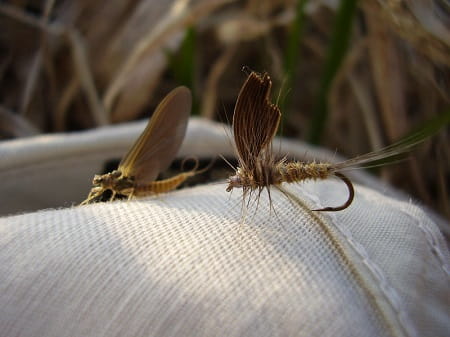
Common methods of fly fishing include dry fly fishing which is when you are fishing on the surface.
Adult insects like mayflies, stoneflies, and caddis, will be present on the surface of the water at times and the trout love eating these flies.
Other floating insects can include beetles, grasshoppers, and crickets.
Nymphing For Trout
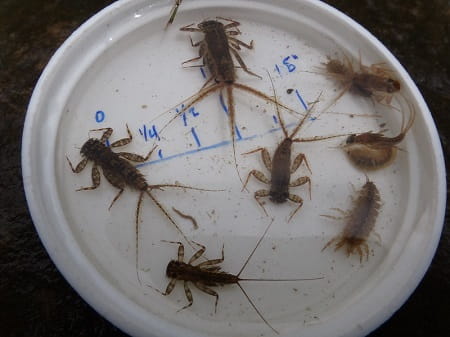
Nymtphing is also another very effective method.
With nymphing, you can choose to drift a nymph below an indicator which is like a mini bobber. An indicator is also known as a strike indicator and it is meant to detect the bites of fish.
Good strike indicator anglers will also use the indicator to suspend the flies off the bottom and will use the indicator to control the speed of their flies which can greatly increase your catch rate.
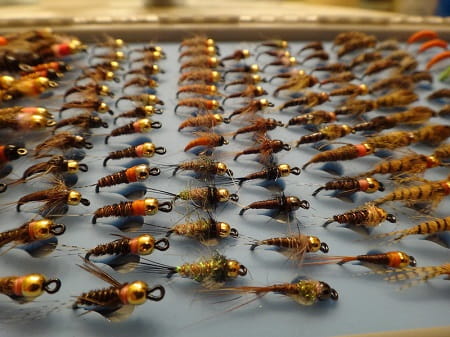
Indicator fishing with a slack line on the water and a floating fly line is probably the most common method for fishing flies below the surface.
I discuss indicator fishing in more detail and explain how to do it much more effectively and tell you which indicator to use, all on my page Indicator Nymphing: 13 Tips From Expert River Guides.
Euro Nymphing For Trout
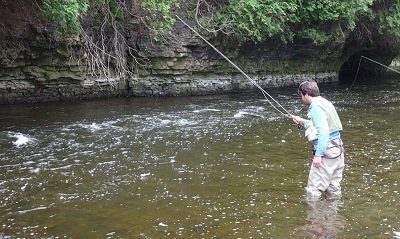
Another nymphing method that does not use a strike indicator is called Euro Nymphing or Modern nymphing and in the right river conditions, this is by far the most effective method for subsurface trout.
This is a tight line method using weighted flies and a colored piece of line within the leader to help you detect bites, control speed, and control your depth.
Euro nymphing is used by ALL the top competitive fly fishing experts.
If you want to catch more big weary brown trout, rainbow trout, and brook trout, you need to learn about Euro Nymphing.
Streamer Fishing For Trout
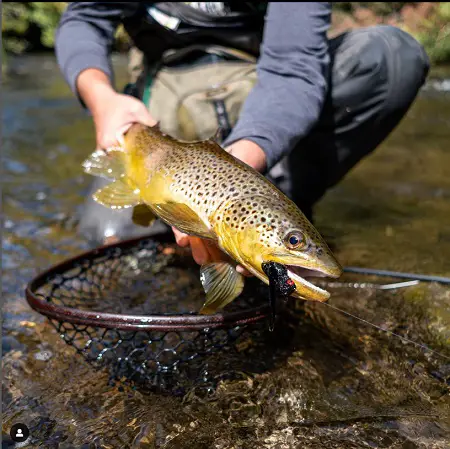
Streamer fishing is a great way to imitate baitfish, leeches, frogs, or a mouse. You are simply casting out these big streamer flies, and then retrieve them using a stripping in-of-the-line retrieve.
Streamer fishing is also a great way to catch some of the biggest trout in the river.
There are many good streamers and some basic and advanced tactics are explained in my article Streamer Fishing For Trout
Keeping Fish And Storing Trout While Fishing
In many parts of the country, anglers fish trout so they can eat them. If you are keeping fish be sure that you know the legal limits.
Many anglers will hold and transport their fish in a plastic bag. Some prefer a basket known as a Fishing Creel.
Releasing Fish
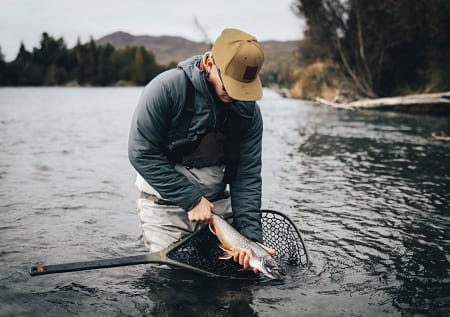
Releasing fish which is also known as catch-and-release fishing is a great way to keep your local fisheries healthy and it allows larger fish a chance to spawn and make more fish.
Releasing wild fish is very important since many times river systems have almost been wiped out due to anglers keeping too many trout.
Releasing smaller fish is normal, but if you plan to catch and release larger fish it makes sense to do it well and protect the fish by keeping them in a net and keeping the fish below the surface of the water while you remove the hooks.
Get yourself a good trout net and use it! See 5 Best Trout Nets And A Guides Advice On How To Attach Them
GUIDE TIP: If a trout dies after releasing it, it’s almost due to excessive exposure to the air, and rarely due to the fight or damage from the hook. I have hooked and released thousand of trout and very rarely have I ever seen a trout die from the hooks.
License Requirements and Fishing Regulations
Most areas will have rules and requirements for fishing trout. In some areas there are trout seasons, there might also be harvest limits, and you will require a fishing license. You may even be required to have a trout tag or trout stamp.
Before your fish be sure you check your local area fisheries department to be sure you know the rules and have a valid fishing license.
7 Essential Guide Tips For More Trout (Plus Bonus)
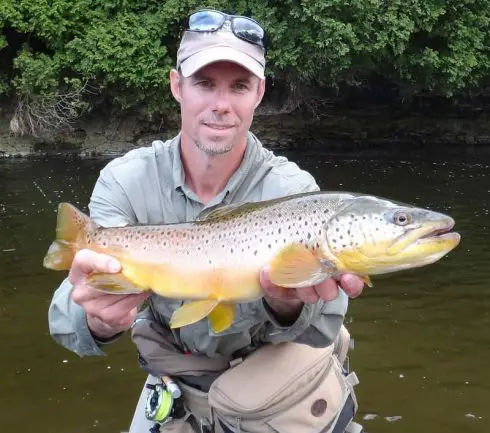
As promised, I said I would provide the essentials to catching far more trout.
These are things river guides always do well and are the reason most good river guides will catch ten times more trout than the average angler.
#1 Presentation
Some say presentation is the key to catching trout, but I only partially agree. Presentation is how you present your bait or lure to the fish. You want to imitate the natural food source as best as possible and there are a few key elements to a great presentation.
#2 Approach
You could have the best presentation in the world but if you approach the river in a way that the big trout see you you will spook them and your presentation will be practically useless. Therefore, ensure you approach the trout in a way that does not spook the,
This approach varies depending on the type of water and the methods you are using.
#3 Stealth
Just like the approach, not letting the trout hear you can be critical to catching trout. I see far too often guys rushing into a pool and spooking every big trout in that pool before they even make their first cast. Slow down, stay low, and stalk the trout like you were hunting it and you will catch far more trout.
#4 Speed Control
Probably the most critical part of your presentation is controlling the speed. With over 22 years of guiding, I would have to say that this is the thing that allows my clients to either catch a lot of fish by controlling the speed of their bait or not catching any fish by not controlling the speed of their bait.
Your bait needs to be drifting down the river at the same speed as all the natural food sources that the trout see, and you probably don’t know this but the speed on the bottom of the river can be over 50% slower than the surface speed. I discuss this in more detail on my page Controlling Your Speed For More Fish When Float Fishing
#5 Depth
Getting your bait and lure close to the trout is important and often the trout will be close to the bottom of the stream or pond.
Learn to get your bit down if you want to catch more trout.
#6 Cover the water
Covering the water is something many guys do not do well, whether they are fishing in a river or a lake, or pond.
You need to learn to read the water and then cover all the parts of the water effectively and thoroughly if you want to maximize how many fish you catch.
I discuss this in my article Effectively Covering The Water When Float Fishing.
#7 Gear
You need to be using gear that is going to make your presentation easier and better. this includes using the right lines, and the right leader setup. It also includes the right lures and the right baits.
This website will help you with that since we provide proven setups and the gear that the guides use.
BONUS – Do It All At Once
My bonus tip is based on watching thousands of anglers fish and seeing what it is that they are doing that prevents them from catching fish.
The 7 essentials above are only as good as the weakest link.
This means if you have a great presentation, but you are using a leader so thick or a hook so big that all the big trout are spooked by it then your presentation won’t matter much.
Or you could have the perfect leader setup, the best bait, and a great hook but if your bait is moving at twice the speed of all the natural food the trout will ignore it.
So, when fishing, you need to try to do each of the 7 essentials well. When you do, you will be catching trout as the experts do.
Trout Fishing Q&A
Thank you for checking out our page on trout fishing. As you have probably seen, guides do some things differently than regular anglers. If you have a question, comment, or tips and advice that you would like to share, let us know in the comments sections below.
Tight Lines
Graham
